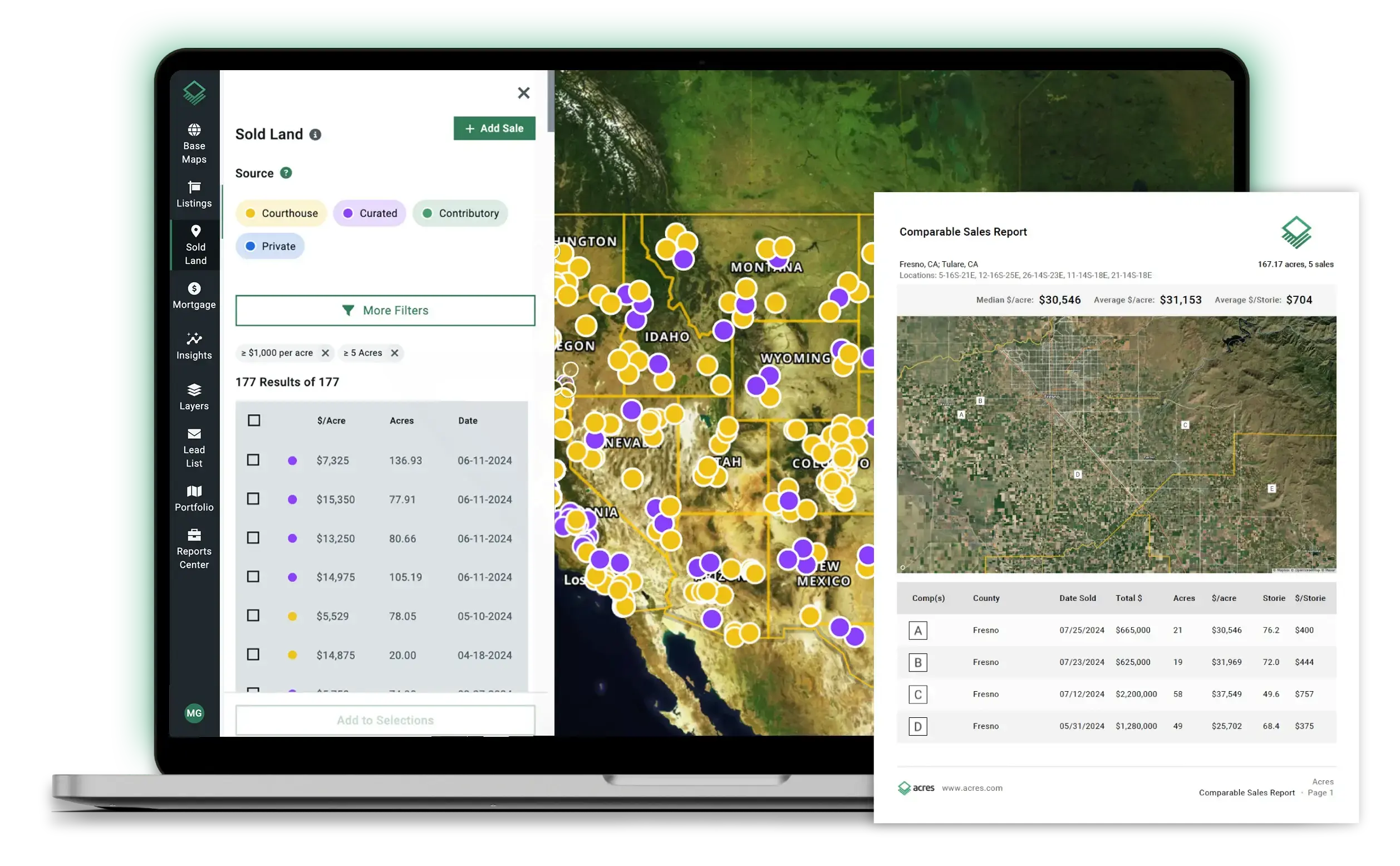Comparable sales are the backbone of broker price opinions (BPOs), market analysis, and valuations. But when it comes to land, finding recent, relevant comps can be challenging.
This is in large part due to spotty sales data and the complexities of land. For example, it's much harder to find a relevant comparable sale for a farm than it is, say, a house or an office building due to the myriad factors that impact land values. From property easements and road access to soil data and zoning, land is a complicated asset to value.
Traditional methods of tracking down land comps can result in outdated data and incomplete information. This is one of the main problems Acres is built to solve.
In this article, we'll cover where to find sales data for land and give you a peek into how Acres is making it faster and easier than ever.
Traditional Methods for Tracking Down Land Comps
Networking with Peers
Reaching out to colleagues and peers for insights on land sales in a region is a tried and true method of finding comps. This approach is grounded in strong professional relationships and frequently results in valuable information sharing. However, its effectiveness is constrained by the size of your network and the willingness of others to collaborate.
Online Listings and Auctions
The internet of course offers access to sold listings, auction results, and real estate marketplaces. While combing through these resources can yield useful comps, it's also time-consuming and often feels like searching for a needle in a haystack.
Public Records and MLS Systems
Public records and Multiple Listing Services (MLS) are commonly used resources for finding historical sales data. Still, in non-disclosure and partial-disclosure states, the information might be incomplete or harder to come by. Also, the vast majority of MLS systems simply aren't built for land.
The Acres Advantage: How to Get the Latest Sales Data
Although traditional methods have their advantages, they also pose challenges like time-consuming processes, dependence on personal networks, and fragmented information sources. Here's how Acres provides an alternative via the largest land sales database available.
A Curated Sales Database
Acres provides land professionals with a curated sales database that simplifies finding relevant comparable sales for land. Our in-house data analysts update this database weekly, ensuring you have access to the most recent, relevant, and accurate sales data. This includes coverage in non-disclosure and partial disclosure states, areas where traditional methods often fall short.
Efficiency and Accuracy
With Acres, the days of making countless calls, sifting through direct mail, and scouring the internet for bits and pieces of data are behind you. Our platform offers a centralized source of information, allowing you to quickly search and find the sales data you need to make informed decisions.
Contextual Details
Not only does Acres provide the latest and most accurate land sales data available, it also provides additional context with details about the sale. On top of that, you can easily take a closer look at insights, like soil productivity, flood risk, vegetation index, and more for any sale.
Benefits for Real Estate Agents and Brokers
Stand Out with Accurate Market Analyses
By leveraging Acres' land sales database, real estate agents and brokers can provide clients with market analyses and property valuations based on reliable, recent data. This sets you apart from competitors who may rely on outdated or incomplete information.
Build Trust and Establish Expertise
Access to reliable data builds trust with your clients and positions you as a knowledgeable expert in the field. When clients see that you have the most recent and relevant information at your fingertips, they're more likely to rely on your guidance and recommendations.
Enhance Negotiation and Closing
Having comprehensive sales data enhances your ability to negotiate and close deals effectively. You can confidently support your pricing and terms with solid data, making the negotiation process smoother and more persuasive.
Uncover Hidden Opportunities
With Acres' extensive database, you can identify emerging market trends and uncover hidden opportunities. This enables you to offer clients options they might not find elsewhere, further distinguishing your services.
Save Time and Increase Efficiency
By eliminating the need to piece together information from multiple sources, you save valuable time. This efficiency allows you to focus more on client relationships and strategic activities that grow your business.
Final Thoughts
While the hunt for relevant land sales has traditionally been a challenge, Acres offers a solution that makes finding this data fast and easy. By switching to Acres, you can move beyond the limitations of traditional methods and step into a future where accurate, comprehensive sales data is readily accessible, empowering you to analyze and value land with confidence.
